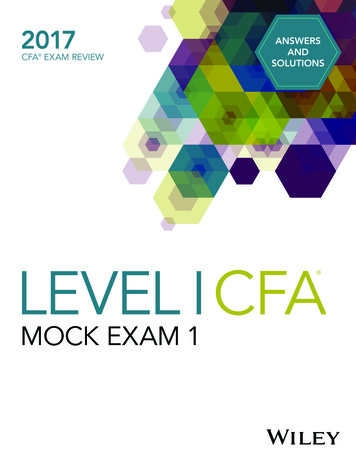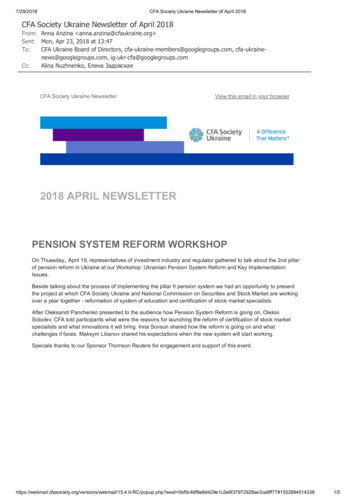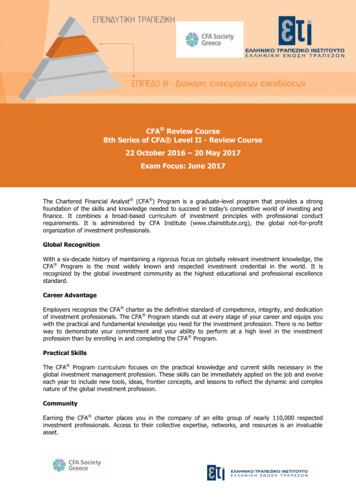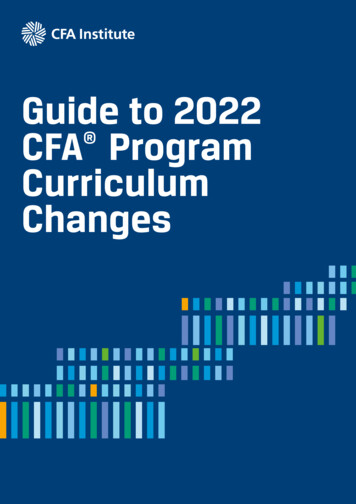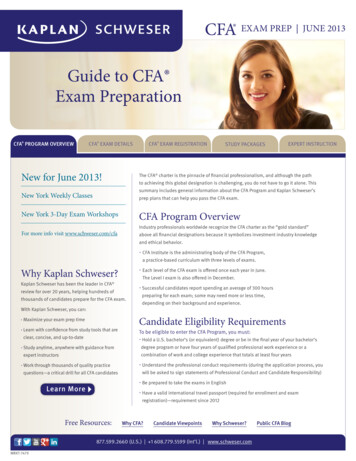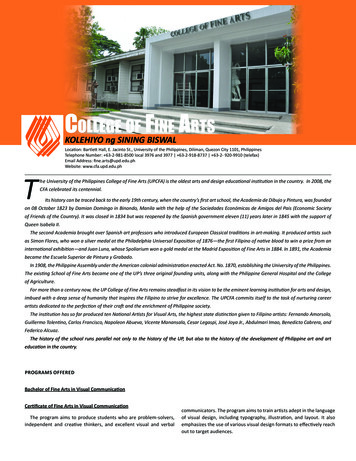
Transcription
Appeared in Proceedings of the 13th USENIXSymposium on Networked Systems Designand Implementation (NSDI ’16)CFA: A Practical Prediction System for Video QoE OptimizationJunchen Jiang† , Vyas Sekar† , Henry Milner , Davis Shepherd , Ion Stoica , Hui Zhang† † CMU, UC Berkeley, Conviva, DatabricksAbstractMany prior efforts have suggested that Internet videoQuality of Experience (QoE) could be dramatically improved by using data-driven prediction of video qualityfor different choices (e.g., CDN or bitrate) to make optimal decisions. However, building such a prediction system is challenging on two fronts. First, the relationshipsbetween video quality and observed session features canbe quite complex. Second, video quality changes dynamically. Thus, we need a prediction model that is(a) expressive enough to capture these complex relationships and (b) capable of updating quality predictions innear real-time. Unfortunately, several seemingly natural solutions (e.g., simple machine learning approachesand simple network models) fail on one or more fronts.Thus, the potential benefits promised by these prior efforts remain unrealized. We address these challenges andpresent the design and implementation of Critical Feature Analytics (CFA). The design of CFA is driven bydomain-specific insights that video quality is typicallydetermined by a small subset of critical features whosecriticality persists over several tens of minutes. This enables a scalable and accurate workflow where we automatically learn critical features for different sessions oncoarse-grained timescales, while updating quality predictions in near real-time. Using a combination of areal-world pilot deployment and trace-driven analysis,we demonstrate that CFA leads to significant improvements in video quality; e.g., 32% less buffering time and12% higher bitrate than a random decision maker.1Global Optimization SystemGlobal view ofvideo qualityPrediction SystemHistory off qualitylitasuremsuremmentsmeasurementsQuality prediction ofpotential decisionDecision MakerMakVideo Streaming EcosystemFigure 1: Overview of a global optimization system andthe crucial role of a prediction system.insight, prior work makes the case for a quality optimization system (Figure 1) that uses a prediction oracle tosuggest the best parameter settings (e.g., bitrate, CDN)to optimize quality (e.g., [33, 11, 35, 32, 20]). Seen in abroader context, this predictive approach can be appliedbeyond Internet video (e.g., [10, 40, 15, 16, 43]).However, these prior efforts fall short of providinga concrete instantiation of such a prediction system.Specifically, we observe that designing such a predictionsystem is challenging on two key fronts (§2): Capturing complex factors that affect quality: Forinstance, an outage may affect only clients of a specific ISP in a specific city when they use a specificCDN. To accurately predict the quality of their sessions, one must consider the combination of all threefactors. In addition, the factors that affect video quality vary across different sessions; e.g., wireless hostsmay be bottlenecked at the last connection, whileother clients may experience loading failures due tounavailability of specific content on some CDNs. Need for fresh updates: Video quality changesrapidly, on a timescale of several minutes. Ideally, wemust make predictions based on recent quality measurements. This is particularly challenging given thevolume of measurements (e.g., YouTube had 231 million video sessions and up to 500 thousand concurrentviewers during the Olympics [7]), compounded withthe need for expressive and potentially complex prediction models.IntroductionDelivering high quality of experience (QoE) is crucialto the success of today’s subscription and advertisementbased business models for Internet video. As prior work(e.g., [33, 11]) has shown, achieving good QoE is challenging because of significant spatial and temporal variation in CDNs’ performance, client-side network conditions, and user request patterns.At the same time, these observations also suggest thereis a substantial room for improving QoE by dynamicallyselecting the optimal CDN and bitrate based on a realtime global view of network conditions. Building on thisUnfortunately, many existing solutions fail on one or1USENIX Association13th USENIX Symposium on Networked Systems Design and Implementation (NSDI ’16) 137
premium video providers. We ran a pilot study on onecontent provider that has 150,000 sessions each day. Ourreal-world experiments show that the bitrates and CDNsselected by CFA lead to 32% less buffering time and 12%higher bitrate than a baseline random decision maker.Using real trace-driven evaluation, we also show thatCFA outperforms many other simple ML prediction algorithms by up to 30% in prediction accuracy and 5-17%in various video quality metrics.Contributions and Roadmap: Identifying key challenges in building an accurate prediction system for video quality (§2). Design and implementation of CFA, built on domainspecific insights to address the challenges (§3-5). Real-world and trace-driven evaluation that demonstrates substantial quality improvement by CFA (§6). Using critical features learned by CFA to make interesting observations about video quality (§7).both counts. For instance, solutions that use less complexmodels (e.g., linear regression, Naive Bayes, or simplemodels based on last-mile connection) are not expressiveenough to capture high dimensional and diverse relationships between video quality and session features. Morecomplex algorithms (e.g., SVM [42]) can take severalhours to train a prediction model and will be inaccuratebecause predictions will rely on stale data.In this work, we address these challenges and presentthe design and implementation of a quality predictionsystem called Critical Feature Analytics (CFA). CFA isbuilt on three key domain-specific insights:1. Video sessions with same feature values have similarquality. This naturally leads to an expressive model,wherein the video quality of a given session can be accurately predicted based on the quality of sessions thatmatch values on all features (same ASN, CDN, player,geographical region, video content, etc). However, ifapplied naively, this model can suffer from the curseof dimensionality — as the number of combinations offeature values grows, it becomes hard to find enoughmatching sessions to make reliable predictions.2. Each video session has a subset of critical featuresthat ultimately determines its video quality. Given thisinsight, we can make more reliable predictions basedon similar sessions that only need to match on critical features. For example, in a real event that we observed, congestion of a Level3 CDN led to relativelyhigh loading failure rate for Comcast users in Baltimore. We can accurately predict the quality of the affected sessions using sessions associated with the specific CDN, region and ISP, ignoring other non-criticalfeatures (e.g., player, video content). Thus, this tackles the curse of dimensionality, while still retainingsufficient expressiveness for accurate prediction (§3).3. Critical features tend to be persistent. Two remaining concerns are: (a) Can we identify critical featuresand (b) How expensive is it to do so? The insighton persistence implies that critical features are learnable from recent history and can be cached and reusedfor fast updates (§4). This insight is derived from recent measurement studies [25, 20] (e.g., the factorsthat lead to poor video quality persist for hours, andsometimes, even days).2Background and ChallengesThis section begins with some background on videoquality prediction (§2.1). Then, we articulate two keychallenges faced by any video quality prediction system:(1) The factors affecting video quality are complex, sowe need expressive models (§2.2); (2) Quality changesrapidly, so models must be updated in near real-time byrecent quality measurements (§2.3). We also argue whyexisting solutions do not address these challenges.2.1BackgroundMost video service providers today allow a video client(player) to switch CDN and bitrate among a set of available choices [33, 20, 32]. These switches have little overhead and can be performed at the beginning of and during a video playback [8]. Our goal then is to choose thebest CDN and bitrate for a client by accurately predicting the video quality of each hypothetical choice of CDNand bitrate. In theory, if we can accurately predict thequality of each potential decision, then we can identifythe optimal decision.To this end, we envision a prediction system that uses aglobal view of quality measurements to make predictionsfor a specific video session. It learns a prediction function for each quality metric Pred : 2S S " R, whichtakes as input a given set of historical sessions S 2Swhose quality is already measured, and a new sessions S, and outputs a quality prediction p R for s.Each quality measurement summarizes the quality of avideo session for some duration of time (in our case, oneminute). It is associated with values of four quality metrics [18] and a set of features2 (summarized in Table 1).Taken together, these insights enable us to engineera scalable and accurate video quality prediction system.Specifically, on a coarse timescale of tens of minutes,CFA learns the critical features, and on a fine timescaleof minutes, CFA updates quality prediction using recentquality measurements. CFA makes predictions and decisions as new clients arrive.We implemented a prototype of CFA and integratedit in a video optimization platform that manages many1 For one session, VSF is zero if it starts successfully, one otherwise.2 By feature, we refer to the type of attribute (e.g., CDN), rather thanvalue of these attributes (e.g., CDN Akamai)2138 13th USENIX Symposium on Networked Systems Design and Implementation (NSDI ’16)USENIX Association
AvgBitrateJoinTimeVideo start failure ction of time a session spends in buffering(smooth playback is interrupted by buffering).Time-weighted average of bitrates in a session.Delay for the video to start playing from the timethe user clicks “play”.Fraction of sessions that fail to start playing(e.g., unavailable content or overloaded server)1 .DescriptionAutonomous System to which client IP belongs.City where the client is located.Type of access network; e.g., mobile/fixed wireless, DSL, fiber-to-home [3].e.g., Flash, iOS, Silverlight, HTML5.Content provider of requested video contents.Binary indicator of live vs. VoD content.Name of the requested video object.CDN a session started with.Bitrate value the session started at.VSFMetricsBufRatioBest 1-FeatureGlobal0.60.40.20051015Time (hour)2025Figure 2: The high VSF is only evident when three factors (CDN, ISP and geo-location) are combined.sions that match on only one or two features. Only whenthree features of CDN (“Level3”), ASN (“Comcast”) andCity (“Baltimore”) are specified (i.e., blue line), can wedetect the high VSF and predict the quality of affectedsessions accurately.In practice, we find that such high-dimensional effectsare the common case, rather than an anomalous cornercase. For instance, more than 65% of distinct CDN-ISPCity values have VSF that is at least 50% higher or lowerthan the VSF of sessions matching only one or two features (not shown). In other words, their quality is affected by a combined effect of at least three features.Limitation of existing solutions: It might be tempting todevelop simple predictors; e.g., based on the last-hopconnection by using average quality of history sessionswith the same ConnectionType value. However, they donot take into account the combined impact of features onvideo quality. Conventional machine learning techniqueslike Naive Bayes also suffer from the same limitation.In Figures 3(a) and 3(b), we plot the actual JoinTimeand the prediction made by the last-hop predictor andNaive Bayes (from Weka [6]) for 300 randomly sampledsessions. The figures also show the mean relative error( predicted actual ). For each session, the prediction algoactualrithms train models using historical sessions within a 10minute interval prior to the session under prediction. Itshows that the prediction error of both solutions is significant and two-sided (i.e., not fixable by normalization).Highly diverse structures of factors. The factors thataffect video quality vary across different sessions. Thismeans the prediction algorithm should be expressiveenough to predict quality for different sessions using different prediction models. For instance, the fact that manyfiber-to-the-home (e.g., FiOS) users have high bitratesand people on cellular connections have lower bitratesis largely due to the speed of their last-mile connection.In contrast, some video clients may experience videoloading failures due to unavailability of specific contenton some CDNs. A recent measurement study [25] hasshown that many heterogeneous factors are correlatedwith video quality issues. In §7, we show that 15% ofvideo sessions are impacted by more than 30 differentcombinations of features and give real examples of different factors that affect quality.Limitation of existing solutions: To see why existing solutions are not sufficient, let us consider the k-nearestTable 1: Quality metrics and session features associated with each session. CDN and Bitrate refer to initialCDN/bitrate values as we focus on initial selections.In general, the set of features depends on the degree ofinstrumentation and what information is visible to a specific provider. For instance, a CDN may know the location of servers, whereas a third-party optimizer [1] mayonly have information at the CDN granularity. Our focus is not to determine the best set of features that shouldbe recorded for each session, but rather engineer a prediction system that can take an arbitrary set of featuresas inputs and extract the relationships between these features and video quality. In practice, the above set of features can already provide accurate predictions that helpimprove quality.Our dataset consists of 6.6 million quality measurements collected from 2 million clients using 3 large public CDNs distributed across 168 countries and 152 ISPs.2.2Best 2-FeatureChallenge 1: Expressive modelsWe show real examples of the complex factors that impact video quality, and the limitations in capturing theserelationships.High-dimensional relationship between video qualityand session features. Video quality could be impactedby combinations of multiple components in the network.Such high-dimensional effects make it harder to learn therelationships between video quality and features, in contrast to simpler settings where features affect quality independently (e.g., assumed by Naive Bayes).In a real-world incident, video sessions of Comcastusers in Baltimore who watched videos from Level3CDN experienced high failure rate (VSF) due to congested edge servers, shown by the blue line in Figure 2.The figure also shows the VSF of sessions sharing thesame values on one or two features with the affected sessions; e.g., all Comcast sessions across different citiesand CDNs. In the figure, the high VSF of the affectedsessions cannot be clearly identified if we look at the ses3USENIX Association13th USENIX Symposium on Networked Systems Design and Implementation (NSDI ’16) 139
00102030Actual JoinTime (sec)(a) Last hop (0.76)10001020300.8200.6CDF20130Actual JoinTime (sec)(b) Naive Bayes (0.61)0.200010201Relative stddev10(a) Temporal variability(c) k-NN (0.63)20Naive Bayesk-NN1510501248Staleness (min)16(b) Impact of staleness on accuracyFigure 4: Due to significant temporal variability ofvideo quality (left), prediction error increases dramatically with stale data (right).neighbor (k-NN) algorithm. It does not handle diverserelationships between quality and features, because thesimilarity between sessions is based on the same function of features independent of the specific session under prediction. In Figure 3(c), we plot the actual valuesof JoinTime and the prediction made by k-NN with thesame setup as Figure 3(a)(b). Similar to Naive Bayesand the last-hop predictor, k-NN has substantial prediction error.Input: Session under prediction s, Previous sessions SOutput: Predicted quality p/* S′ :identical sessions matching on allChallenge 2: Fresh updatesfeatures with s in recent history( )*/the identical sessions in S′ .*/1S′ SimilarSessionSet(s, S, AllFeatures, );/* Summarize the quality (e.g.,median) of2p Est(S′ );return p;3Algorithm 1: Baseline prediction that finds sessions matching on all features and uses their observed quality as the basis for prediction.Video quality has significant temporal variability. In Figure 4(a), for each quality metric and combination of specific CDN, city and ASN, we compute the mean quality of sessions in each 10-minute interval, and then plotthe CDF of the relative standard deviation ( stddevmean ) of thequality across different intervals. In all four quality metrics of interest, we see significant temporal variability;e.g., for 60% of CDN-city-ASN combinations, the relative standard deviation of JoinTime across different 10minute intervals is more than 30%. Such quality variability has also been confirmed in other studies (e.g., [33]).The implication of such temporal variability is that theprediction system must update models in near real-time.In Figure 4(b), we use the same setup as Figure 3, exceptthat the time window used to train prediction models isseveral minutes prior to the session under prediction. Thefigure shows the impact of such staleness on the prediction error for JoinTime. For both algorithms, predictionerror increases dramatically if the staleness exceeds 10minutes. As we will see later, this negative impact ofstaleness on accuracy is not specific to these predictionalgorithms (§6.3).Limitation of existing solutions: The requirement to usethe most recent measurements makes it infeasible to usecomputationally expensive models. For instance, it takesat least one hour to train an SVM-based prediction modelfrom 15K quality measurements in a 10-minute intervalfor one video site, so the quality predictions will be basedon information from more than one hour ago.30.130Actual JoinTime (sec)Figure 3: Prediction error of some existing solutions issubstantial (mean of relative error in % increase in avgprediction error1030Predicted JoinTime (sec)20Predicted JoinTime (sec)Predicted JoinTime (sec)30from the curse of dimensionality. Fortunately, we canleverage a second insight that each video session has asubset of critical features that ultimately determine itsvideo quality. We conclude this section by highlightingtwo outstanding issues in translating these insights into apractical prediction system.3.1Baseline prediction algorithmOur first insight is that sessions that have identical feature values will naturally have similar (if not identical)quality. For instance, we expect that all Verizon FiOSusers viewing a specific HBO video using Level3 CDNin Pittsburgh at Fri 9 am should have similar quality(modulo very user-specific effects such as local Wi-Fiinterference inside the home). We can summarize theintuition as follows:Insight 1: At a given time, video sessions having samevalue on every feature have similar video quality.Inspired by Insight 1, we can consider a baseline algorithm (Algorithm 1). We predict a session’s qualitybased on “identical sessions”, i.e., those from recent history that match values on all features with the session under prediction. Ideally, given infinite data, this algorithmis accurate, because it can capture all possible combinations of factors affecting video quality.However, this algorithm is unreliable as it suffersfrom the classical curse of dimensionality [39]. Specifically, given the number of combinations of feature values (ASN, device, content providers, CDN, just to namea few), it is hard to find enough identical sessions neededIntuition behind CFAThis section presents the domain-specific insights we useto help address the expressiveness challenge (§2.2). Thefirst insight is that sessions matching on all features havesimilar video quality. However, this approach suffers4140 13th USENIX Symposium on Networked Systems Design and Implementation (NSDI ’16)USENIX Association
to make a robust prediction. In our dataset, more than78% of sessions have no identical session (i.e., matchingon all features) within the last 5 minutes.3.21Critical featuresIn practice, we expect that some features are more likelyto “explain” the observed quality of a specific video session than others. For instance, if a specific peering pointbetween Comcast and Netflix in New York is congested,then we expect most of these users will suffer poor quality, regardless of the speed of their local connection.*/sessions in S′ .*/S′ SimilarSessionSet(s, S,CFs , );/* Summarize the quality of the similar3p Est(S′ );return p;Algorithm 2: CFA prediction algorithm, where prediction is based on similar sessions matching oncritical features.(e.g., PCA or SVM). This allows domain experts to combine their knowledge with CFA and diagnose predictionerrors or resolve incidents, as we explore in §7.2.At this time, it is useful to clarify what critical features are and what they are not. In essence, critical features provide the explanatory power of how a predictionis made. However, critical features are not a minimalset of factors that determine the quality (i.e., root cause).That is, they can include both features that reflect theroot cause as well as additional features. For example, ifall HBO sessions use Level3, their critical features mayinclude both CDN and Site, even if CDN is redundant,since including it does not alter predictions. The primaryobjective of CFA is accurate prediction; root cause diagnosis may be an added benefit.We already saw some real examples in §2.2: in theexample of high dimensionality, the critical featuresof the sessions affected by the congested Level3 edgeservers are {ASN,CDN,City}; in the examples of diversity, the critical features are {ConnectionType} and{CDN,ContentName}. Table 2 gives more real examples of critical features that we have observed in operational settings and confirmed with domain experts.Set of critical features{Player, Site}{CDN, Site,ContentName}{CDN,City, ASN}Table 2: Real-world examples of critical features confirmed by analysts at a large video optimization vendor.3.3A natural implication of this insight is that it can helpus tackle the curse of dimensionality. Unlike Algorithm 1, which fails to find a sufficient number of sessions, we can estimate quality more reliably by aggregating observations across a larger amount of “similarsessions” that only need to match on these critical features. Thus, critical features can provide expressivenesswhile avoiding curse of dimensionality.Algorithm 2 presents a logical view of this idea:1. Critical feature learning (line 1): First, findthe critical features of each session s, denoted asCriticalFeatures(s).2. Quality estimation (line 2, 3): Then, find similarsessions that match values with s on critical featuresCriticalFeatures(s) within a recent history of length (by default, 5 minutes). Finally, return some suitableestimate of the quality of these similar sessions; e.g.,the median3 (for BufRatio, AvgBitrate, JoinTime) orthe mean (for VSF).A practical benefit of Algorithm 2 is that it is interpretable [52], unlike some machine learning algorithms3 Wecritical features CFs with s.24Insight 2: Each video session has a subset of criticalfeatures that ultimately determines its video quality.Quality issueIssue on one player of VevoESPN flipping between CDNsBad Level3 servers for Comcast users in MarylandInput: Session under prediction s, Previous sessions SOutput: Predicted quality p/* CFs :Set of critical features of s*/CFs CriticalFeatures(s);/* S′ :Similar sessions matching values onPractical challengesThere are two issues in using Algorithm 2.Can we learn critical features? A key missing pieceis how we get the critical features of each session (line1). This is challenging because critical features vary bothacross sessions and over time [33, 25], and it is infeasibleto manually configure critical features.How to reduce update delay? Recall from §2.3 thatthe prediction system should use the most recent qualitymeasurements. This requires a scalable implementationof Algorithm 2, where critical features and quality estimates are updated in a timely manner. However, naivelyrunning Algorithm 2 for millions of sessions under prediction is too expensive (§6.3). With a cluster of 32 cores,it takes 30 minutes to learn critical features for 15K sessions within a 10-minutes interval. This means the prediction will be based on stale information from tens ofminutes ago.4CFA Detailed DesignIn this section, we present the detailed design of CFAand discuss how we address the two practical challengesmentioned in the previous section: learning critical features and reducing update delay.use median because it is more robust to outliers.5USENIX Association13th USENIX Symposium on Networked Systems Design and Implementation (NSDI ’16) 141
Notationss, S, SDomainsq(s)QualityDist(S)f , F, FS ! R2S ! 2RCriticalFeatures(s) S ! 2FVFV ( f , s)F S ! VFSV (F, s)2F S ! 2VSimilarSessionSet(s, S, F, )F 2F S R ! 2FDefinitionA session, a set of sessions, set of all sessionsQuality of s{q(s) s S}A feature, a set of features,set of all featuresCritical features of sSet of all feature valuesValue on feature f of sSet of values on features inF of s{s′ s′ S,t(s) t(s′ ) t(s), FSV (F, s′ ) FSV (F, s)}12345Table 3: Notations used in learning of critical features.The key to addressing these challenges is our third andfinal domain-specific insight:6Insight 3: Critical features tend to persist on longtimescales of tens of minutes.7This insight is derived from prior measurement studies [25, 20]. For instance, our previous study on sheddinglight on video quality issues in the wild showed that thefactors that lead to poor video quality persist for hours,and sometimes even days [25]. Another recent studyfrom the C3 system suggests that the best CDN tends tobe relatively stable on the timescales of few tens of minutes [20]. We independently confirm this observation in§6.3 that using slightly stale critical features (e.g., 30-60minutes ago) achieves similar prediction accuracy as using the most up-to-date critical features. Though this insight holds for most cases, it is still possible (e.g., on mobile devices) that critical features persist on a relativelyshorter timescale (e.g., due to the nature of mobility).Note that the persistence of critical features does notmean that quality values are equally persistent. In fact,persistence of critical features is on a timescale an orderof magnitude longer than the persistence of quality. Thatis, even if quality fluctuates rapidly, the critical featuresthat determine the quality do not change as often.As we will see below, this persistence enables (a) automatic learning of critical features from history, and (b)a scalable workflow that provides up-to-date estimates.104.18911Input: Session under prediction s, Previous sessions SOutput: Critical features for s/* Initialization*/MaxSimilarity , CriticalFeatures NULL;/* D f inest :Quality distribution ofsessions matching on F in learn .*/D f inest QualityDist(SimilarSessionSet(s, S, F, learn ));for F 2F do/* Exclude F without enough similarsessions for prediction.*/if SimilarSessionSet(s, S, F, ) n thencontinue;/* DF :Quality distribution ofsessions matching on F in learn .*/DF QualityDist(SimilarSessionSet(s, S, F, learn ));/* Get similarity of D f inest & DF . */Similarity Similarity(DF , D f inest );if Similarity MaxSimilarity thenMaxSimilarity Similarity;CriticalFeatures F;return CriticalFeature;Algorithm 3: Learning of critical features.most similar to that of sessions matching on all features. For instance, suppose we have three features⟨ContentName, ASN, CDN⟩ and it turns out that sessionswith ASN Comcast, CDN Level3 consistently havehigh buffering over the last few hours due to some internal congestion at the corresponding exchange point.Then, if we look back over the last few hours, thedata from history will naturally reveal that the distribution of the quality of sessions with the featurevalues ⟨ContentName Foo, ASN Comcast, CDN Level3⟩ will be similar to ⟨ContentName , ASN Comcast, CDN Level3⟩, but very different from, say,the quality of sessions in ⟨ContentName , ASN , CDN Level3⟩, or ⟨ContentName , ASN Comcast, CDN ⟩. Thus, we can use a data-drivenapproach to learn that ASN, CDN are the critical features for sessions matching ⟨ContentName Foo, ASN Comcast, CDN Level3⟩.Algorithm 3 formalizes this intuition for learning critical features. Table 3 summarizes the notation used inAlgorithm 3. For each subset of features F (line 3), wecompute the similarity between the quality distribution(DF ) of sessions matching on F and the quality distribution (D f inest ) of sessions matching on all features (line7). Then, we find the F that yields the maximum similarity (line 8-10), under one additional constraint thatSimilarSessionSet(s, S, F, ) should include enough (bydefault, at least 10) sessions to get reliable quality estimation (line 4-5). This check ensures that the algorithmwill not simply return the set of all features.Learning critical featuresRecall that the first challenge is obtaining the critical features for each session. The persistence of critical featureshas a natural corollary that we can use to automaticallylearn them:Corollary 3.1: Persistence
CFA learns the critical features, and on a fine timescale of minutes, CFA updates quality prediction using recent quality measurements. CFA makes predictions and deci-sions as new clients arrive. We implemented a prototype of CFA and integrated it in a video optimization platform that manages many premium video providers. We ran a pilot study .


